#grassland invertebrates
Explore tagged Tumblr posts
Text



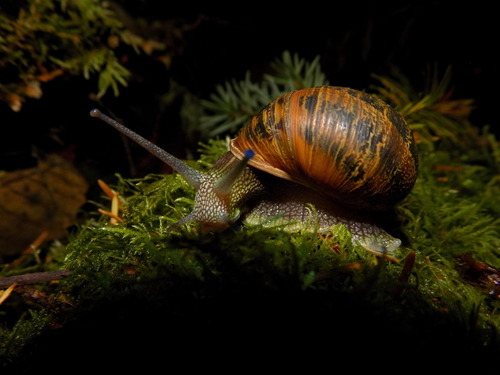
Life in the Slow Lane: The Brown Garden Snail
Perhaps the most widely known member of the mollusk group, the brown garden snail (Cornu aspersum), also known as the European garden snail, is native to the Mediterranean region of southern Europe and northern Africa, and his since spread to every continent except Antarctica. It thrives in temperate zones, particularly in open forests, coastal dunes, and urban parks and agricultural spaces. This spread has largely been facilitated by humans, and may have started as early as the Neolithic era nearly 8500 years ago.
The brown garden snail's name is an excellent descriptor of the species; both the body and the shell are mainly shades of brown. Generally the body is lighter than the shell, and secretes a thin layer of mucus to keep itself moist. The shell is about 2.5 to 4 cm (0.98-1.57 in) wide, while the body itself is roughly 5-9 cm (1.97-3.54 in) long. Body and shell combined, C. aspersum only weighs 15g (0.53 oz) at maximum. The body is made of two parts; the head, which carries the eye stalks, mouth, and sensory tentacles; and the foot, essentially a large muscle which the snail uses to move from place to place. The rest of its organs, including the heart, lungs, stomach, and anus are contained within the shell itself. Only the genital pore, located on the side of the foot, is exposed.
C. aspersum is primarily an herbivore, feeding on leaves, flowers, and fruits, as well as rotting plant and animal matter. In order to obtain the calcium it needs to build and maintain its shell, the European garden snail also occasionally consumes soil. Because of its slow nature, reaching a maximum of only 2.4 mm/s (0.09 in/s), this species is a common food item for other predatory snails, centipedes, glow worms, small mammals, lizards, frogs, and birds. However, the brown garden snail is able to retreat into its shell and produce a thick, frothy mucus membrane when threatened.
Like other terrestrial mollusks, the European garden snail is a hermaphroditic species, possessing both male and female gametes. Individuals may reproduce year round, provided with plentiful resources and good environmental conditions. When two snails encounter each other and wish to mate, each one spears the other with a hard calcite spine, known as a love dart. These darts allow the two to exchange sperm, and the process may take several hours. Afterwards, an individual may store viable sperm for up to 4 years. About ten days after a snail fertilizes its sperm, it lays about 50 eggs in a sheltered area; a single snail may do this up to 6 times a year. Eggs take between 2-4 weeks to hatch, and emerge with a soft shell. It takes about 10 months for juveniles to reach full maturity, and they may live up to 3 years in the wild.
Conservation status: C. aspersum has been rated as Least Concern by the IUCN. In both its introduced and native range, it is considered a pest species due to its consumption of crops. However, this species has also been adopted in some areas as a pet or as an edible delicacy.
If you like what I do, consider leaving a tip or buying me a ko-fi!
Photos
Bill Frank
Alan Henderson
Kostas Zontanos
Rand Workman via iNaturalist
#brown garden snail#european garden snail#Stylommatophora#Helicidae#land snails#snails#gastropods#mollusks#invertebrates#deciduous forests#deciduous forest invertebrates#grasslands#grassland invertebrates#urban fauna#urban invertebrates#europe#southern europe#africa#north africa#animal facts#biology#zoology
112 notes
·
View notes
Text

Forest or Chestnut Chockchafer, Melolontha hippocastani Canon 400D EF 100 2.8 f/3.5 1/200 iso: 400 Celakovice-Jirina, Czech Republic 5/22/2011
#chafers#Cockchafers#beetles#Scarabs#Scarabidae#Coleoptera#insects#invertebrates#macro#woodlands#insectphotography#macrophotography#insect#canon#grasslands
69 notes
·
View notes
Note
Hi. My wife referred me to you for your knowledge and enthusiasm for ecology. If I wanted my fictional fantasy world to have a saltwater river (my world is weird), how could I explain or justify that? Is it even possible, ecologically speaking? Anyway, love your posts and thank you!
I have been considering this with my colleague who is a physical geographer with a passion for riverine geomorphology and she wants to sit down with me and discuss the possibilities more fully. So I may yet update this post with more options.
But, the short answer is yes, there are options to make it possible.
The one we've best fleshed out so far basically comes down to groundwater contamination. Groundwater is contaminated with massive salt input (this would likely need to be anthropogenic - up to you whether that looks like Evil Factory Output, massive magical damage post-war, or any other consideration.) One or more of the river's main tributaries is fed primarily by this groundwater store, so it cannot flush through. Once it meets the sea, it would be brackish around the estuary anyway, but this would mean halophilic species - those tolerant of salt - would be able to spread backwards back up the river channel. Depending on what you want, for plants this could mean cordgrasses (saltmarsh formers), seagrasses along the riverbed in slower areas, or potentially long, linear stands of mangrove forest; in all of those cases, it's much more likely on a slower river than a faster one.
Now, a salt river will be far more erosional than a fresh one, so the river banks and bed would be eroding more. This means higher quantities of suspended sediment in the water, so the water colour would be murkier and browner than if it were fresh. However, if its a river with slow meanders, you might get little patches of saltmarshes establishing, where the erosion turns into deposition instead, so although the water would have a colour difference it would be extreme; on faster bits, though, it would.
There would be, either from the groundwater at the top of the catchment or along the river channel, a certain amount of salt incursion into land. This would basically make arable agriculture in those areas nigh-on impossible, but you could maybe try farming something like samphire along the banks. The exception would be areas that were away from the contaminated aquifer, that also got plenty of rainfall OR freshwater groundwater imputs from another part of the catchment. Even then, though, it couldn't go too close to the river.
Floodplains need considering, too! Floodplains only flood during wet weather events that cause the river to overtop the banks; the rest of the year, they're dry. In this case, that means you might have areas that are freshwater marshes, or maybe even normal grasslands/scrub for most of the year, which then suddenly get inundated with salt. That'll kill all those organisms quite rapidly. You wouldn't have any trees in those areas, and they'd look like mudbaths for the majority of the time, I'd imagine. Very ugly wastelands. These would then provide even more lost soil into the river, for even more browning of the water.
That much sediment would therefore mean the estuary would be a depositional one - new land forms at it. It would probably have a delta. This means lots of mudflats with lots of marine worms and other invertebrates, and consequently insane levels of wading bird diversity to feed on them (plus foodstuffs - oysters, cockles, octopus, smaller fishes, etc). Loot up Korean getbol for an idea of how impressive these things can get. Saltmarshes and/or mangrove forests, too! Depending on climate. Mangroves are a tropical species.
HOWEVER, this is just one idea we've explored so far, so I shall update you if we think of others
480 notes
·
View notes
Text
Hello! Sorry for the inactivity, posting the same drawings on 5 different platforms with different limitations is quite exhausting, so I'll be posting my Spectember drawings in batches until I finish it :>
So without further ado, here's the second week of Spectember:
Day 8: Ambush Predator
Featuring the Titan Låtmimik (Venatoramus longus), a giant carnivorous katydid from the northern forests of Antarctica, which can imitate the calls of certain bird species to attract them closer to their lethal grasp
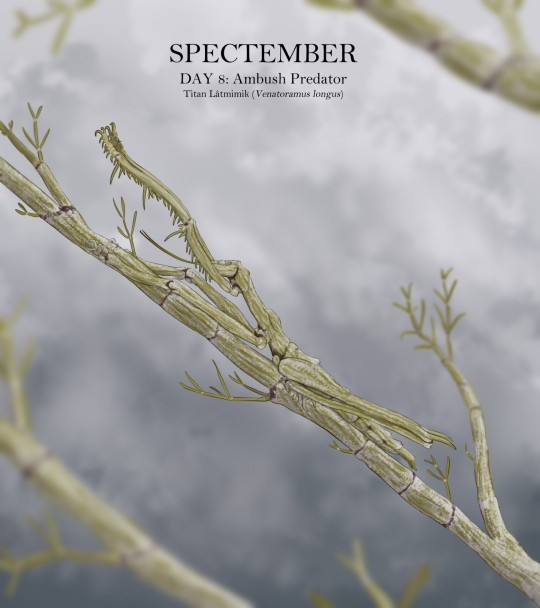
Day 9: Producer
Featuring the Ggulu Orchid (Caelorchis divinitus), an orchid common in the Muraanad forests of the Somalian subcontinent, where it grows from the fungi growing chambers of the termite nests, taking advantage of the fungi until it bursts out of the nest, finally able to photosynthesize and flower.

Day 10: Filter Feeder
Featuring the Wandering Dumingo (Pinnatocetus celer), a seafaring member of the dumingos, a family of filter feeding mallard descendants, which embark on incredibly long migrations across oceans, from pole to pole, in the search of summer plankton booms.

Day 11: Semi-aquatic
Featuring the Beringian Selkie (Sennapithecoides polaris), an aquatic rodent from the Arctic region, which spends most of its life diving and digging around the coastal mudflats in search of invertebrates to feed on, including clams and crustaceans.

Day 12: Megafaunal
Featuring the Transoceanic Navalodile (Galleonosuchus imperator), the largest of a group of seagoing crocodiles, which patrols the equatorial waters of the Pacific and Atlantic oceans, constantly searching for fish, rarely encountering others of its kind.

Day 13: Grazer
Featuring the Rugose-browed Pricklyhog (Hoplohippus rugosus), a large porcupine descendant that lives in the African grasslands, protected from predators by its thick skin, and large keratinous plaques and spines that cover it.

And day 14, some fanart of one of the OG spec books, After Man. One of my favourite creatures from its incredible roster, the Night Stalker!

#art#illustration#clip studio paint#speculative evolution#speculative biology#fanart#art challenge#spectember 2024#spectember
54 notes
·
View notes
Text
How to Get Into Bugs

"A world of dreams and adventures with bugs awaits! Let's go!"
What are bugs? In this document when I say “bugs”, I refer to small invertebrate animals like insects, spiders, snails, and worms. These creatures are underappreciated, and their importance to the health and function of life on Earth cannot be overstated. Bugs aerate the soil, pollinate plants, spread seeds, clean up dead plants and animals, provide food for countless species, prey upon countless others, and cycle nutrients across the planet, among other services.
Bugs are amazing creatures. They come in a vast variety of shapes and colors, from the shining wings of a blue morpho butterfly to the pebble-like body of a toad bug. Their habits and behaviors are just as complex as those of larger animals. Stick insects sway as they walk to mimic a branch blown in the wind, mud dauber wasps gather mud to build earthen nests, and moths read the stars to navigate in the dark. Because they are small, bugs can be supremely adapted to their environment. Many insects will form relationships with specific plants, only pollinating or laying their eggs on these species.
There are many mysteries left to uncover about bugs. Insects alone make up 75% of known animal species, with more being discovered every day. These species are not only being found in remote forests and grasslands, but in woods, parks, and other habitats closer to home. You may be the first to discover a rare creature found only in your area! It is not only new species that present us with mysteries. There is ongoing research into even common species, to answer questions like how flies land upside down, how beetles fold their wings, or how bees make decisions on where to build their nests.
If you appreciate them, the world will become more vibrant. Wherever you are, you can almost certainly find bugs. By noticing these creatures living around you, you will become more aware of nature not as an untouched ideal found only in mountain rainforests or ocean trenches, but as the life that permeates even the most “average” places.

How Can I Get into Bugs?
Go for a walk! As you are walking, take the time to look closely at your surroundings. Notice the different species of insects you see flying around. Look at the leaves and branches of plants. Turn over rocks and bricks. Do you see any bugs? Focus on one of the animals you see. What is it doing? Searching for food? Resting? Building a nest? Have you ever seen this bug before? What is it called? What is its life cycle like? These questions provide starting points that you can use to learn about the creatures that live alongside you.
Get acquainted through books, websites, and videos! Field guides and websites like iNaturalist serve as great first steps to familiarizing yourself with the species found in your area. Select a favorite species or family of bugs, then go out to search for them in the wild. Online resources can also be used to overcome phobias. If you find yourself creeped out by an animal, you can look up videos online to get used to its appearance and movements.
Gather some useful gear! If you are looking to catch bugs for photography or collection, you'll want to have a jar of some kind to contain them. Mason jars work well for large specimens and 2 oz. travel sized jars work well for smaller animals. Flying insects like moths and dragonflies can be captured with a butterfly net, while sweep nets can be brushed against vegetation to collect crawling animals. Dip nets are made for use in water and can be used to capture shrimp and snails along with aquatic insects. In addition to bug-specific equipment you may want gear like a bookbag, sunscreen, hiking boots, canteen, and long pants if you are going out into wilder areas.
Know where to look! Different species of animals need different resources to survive, so they will be found in different places. Look beneath logs or dead leaves to find isopods, millipedes, and earthworms. Ponds and other water bodies are often home to water skaters, crayfish, and water beetles. Flowering plants are a good place to find bees, butterflies, and wasps. Caterpillars, aphids, and planthoppers can often be found on leaves and branches. Some species of insects can only be found on particular plants. Whenever you find a new plant species, take a closer look to see what is living on it. Also be aware of what time you go out searching. If you go to the same location during the day and night, different creatures will be active.
Keep a record of your adventures! Whether it be a digital photo album, a collection of preserved insects, or a written diary, records will provide you with an easy way to revisit memories of your exploits. You might also have more fun exploring the world of bugs if you have a personal project to develop.
Raise bugs in captivity! Caterpillars and beetles can be raised over a season and released when they undergo metamorphosis. Snails and isopods are easy to keep so long as they are fed vegetable scraps and have humid places to hide in their enclosure. Many insects, spiders, snails, and other invertebrates are easy to care for in vivariums. Just be sure not to overcollect! While many bugs have healthy populations, others need as many wild breeding individuals as possible. Entirely avoid collecting endangered species or taking animals from protected areas.

Help Your Local Environment!
Insects, arachnids, and other invertebrates serve as essential building blocks to the global ecosystem and help to keep our world functioning. There are many ways you can help bugs:
If you enjoy gardening or landscaping, grow some plants native to your area. Native plants provide local species with food and shelter, and because they are adapted to your habitat, often require less care than exotic plants.
Avoid spraying pesticides and herbicides unless truly necessary. Not only can these substances kill off non-target species, they can also increase the populations of pesticide-resistant species, runoff from their site of application, and seep into local soil and water supplies.
Select a woodland, meadow, or section of waterway and keep it clean of litter. Pollution may be a global issue, but the world is made up of places, and you can make tangible change in your local area. See if you can get some friends together to help out. Cleanup efforts are most enjoyable with a few extra hands!
You can protect your local woods, creeks, or other wilderness spaces by working with your community’s hobbyists and environmental organizations, learning about your local ecosystem, and sharing your thoughts with others.
Many of the environmental, societal, and health issues we face are interconnected. Thus, improving one situation will make it easier to address others. Whatever problem you are most equipped to face, do your best. Even the smallest action you can take changes the future and makes it that much better.
Online Resources
https://www.inaturalist.org/observations/ - Explore worldwide observations of living things.
https://xerces.org - The Xerces Society for Invertebrate Conservation is an international nonprofit organization that protects the natural world through the conservation of invertebrates and their habitats.
https://en.wikipedia.org/wiki/Portal:Arthropods - Wikipedia information on arthropods, their habits, and biology.
https://bugguide.net/node/view/15740 - Information on bugs from the United States and Canada.
https://www.pbs.org/show/deep-look/ - Explore big scientific mysteries by going incredibly small.
Chromatophone Nature Youtube Channel – No-Commentary wildlife footage, like a virtual nature walk.
Thank you for reading! For a PDF version of this post, visit my blog an check the pinned post.
48 notes
·
View notes
Text


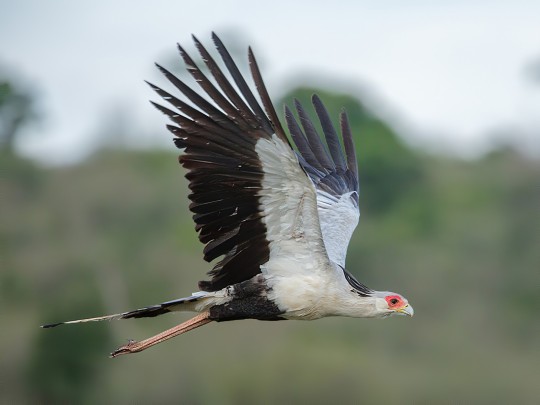
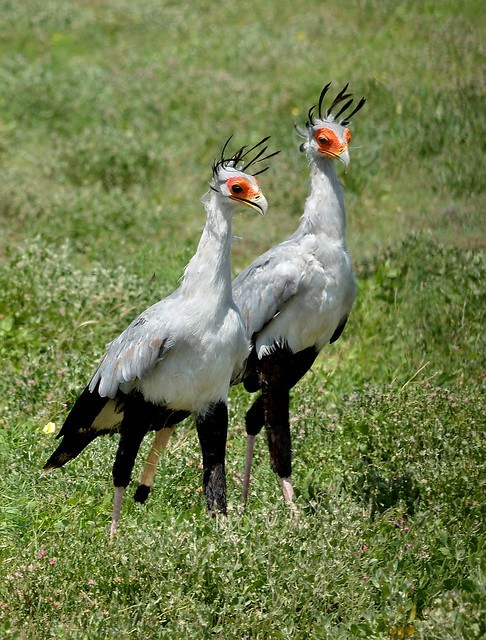
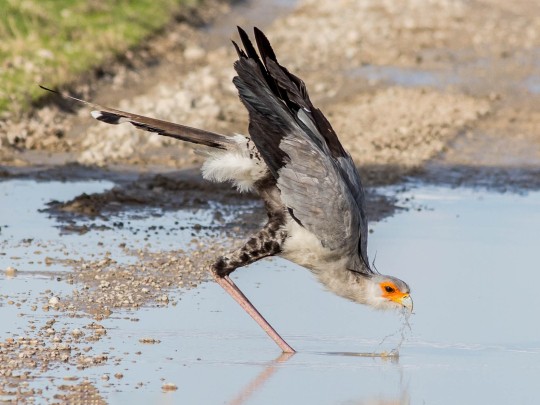
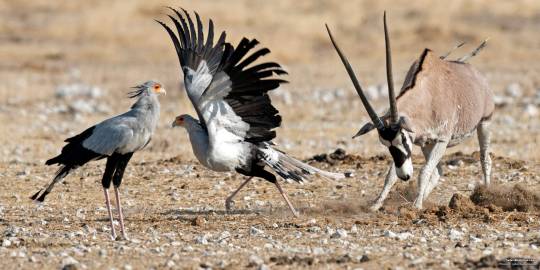

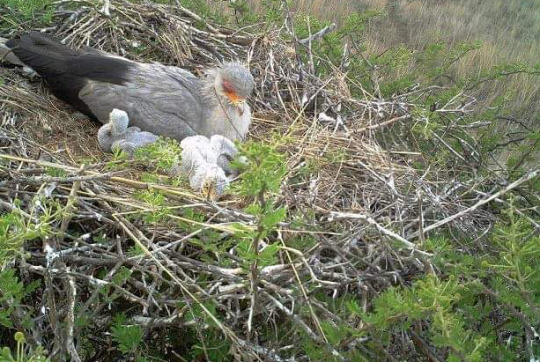


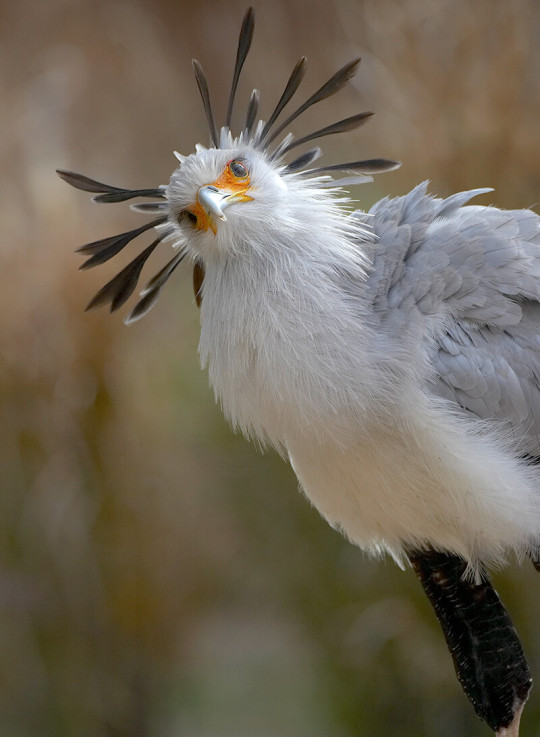
The secretarybird or secretary bird is a species of is a large, mostly terrestrial, bird of prey which is endemic to sub-saharan Africa. The secretarybird prefers to inhabit open grasslands, savannas, shrublands, and highlands rather than rainforests, swamps, and woodlands. In these habitats Secretarybirds will form monogamous pairs and defend a large territory of around 19 square miles ( 50 km2), and while capable of flight secretary birds are a primarily terrestrial animal. Hunting in pairs or with there offspring they stalk through there habitat in long careful strides in search of prey such as large invertebrates, lizards, amphibians, small turtles and tortoises, hares, hedgehogs, rodents, polecats, small felines, young gazelle, mongoose, birds up to the size of guinea fowl, and especially snakes. Once found a secretarybird will chase after prey with the wings spread and kill by striking with swift blows of the feet. Standing around 4.3ft (1.3m) tall, 3.7 to 4.11ft (1.1 to 1.5m) in body length, with a 6.3 to 6.11ft (1.9 to 2.1m) wingspan. The secretarybird is a large instantly recognizable bird with an eagle-like body on crane-like legs, featherless red-orange face and predominantly grey plumage, with a flattened dark crest and black flight feathers and thighs.Breeding may occur year round and during courtship, they exhibit a nuptial display by soaring high with undulating flight patterns and calling with guttural croaking. Males and females can also perform a ground display by chasing each other with their wings up and back. Both sexes build a relatively flat 3 to 5ft (1 to 1.5m) wide platform nest out of sticks and grasses at the top of a dense thorny tree, some 8 to 40ft (2.5 to 13m) above the ground. Here 1 to 3 chalky blueish whiteish green eggs are laid and incubated for 45 days until hatching. The young remain with there parents until becoming independent at some 4 to 7 months of age. Under ideal conditions a secretarybird may live upwards of 15 years.
#pleistocene pride#pleistocene#pliestocene pride#pliestocene#cenozoic#ice age#stone age#dinosaur#bird#secretarybird#secretary#secretary bird
162 notes
·
View notes
Text
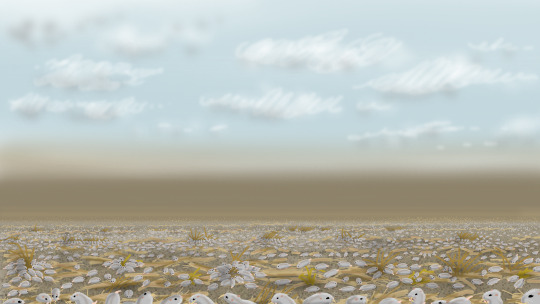
'The Early Rodentocene, 100 years post-establishment.
Before it was a paradise, it was a hamster hellscape.
Without predators to curb their numbers and a nigh-limitless supply of food, the first hamsters, having escaped the confines of Isla Genesis via land bridges that formed during a period of low sea levels, bred incessantly and exponentially. In the span of a century, they numbered in the hundreds of billions, becoming a tidal wave of hungry nibbling mouths that swept through Nodera, and then Easaterra, Westerna and Ecatoria like a rodent plague of continental proportions. They quickly ravaged the local plant life and introduced invertebrates, reducing once-lush grassland into barren wastes and driving many species of colonists to extinction as their numbers grew unchecked, their consumed biomass converted into even more hungry hamsters.
Eventually, having overrun the still-interconnected four main continents, they finally ran out of food, and began starving en masse: heaps upon heaps of tiny carcasses blanketing the landscape for miles on end and emanating the most terrible smell imaginable all across the land as they decomposed, a nauseating miasma of dead rodent times a hundred billion. And yet, in this putrid panorama of death and decay, some life endured. Fungi and microbes and flies and worms soon returned the nutrients of the dead to the soil, and dormant seeds and insect eggs awaiting the end of the scurrying storm burst back into bloom, nourished by the now richer earth. Trees, boasting lifespans measured in centuries, simply held off producing seeds and filled their leaves with distasteful tannins until the menacing swarms died down. Floating seeds and flying insects, blown across the sea from offshore islands and the unreachable Borealia, blew back inland and colonized the continents once again. And, with a new, enriched environment, new life flourishing once more, the world again became a paradise for the few hardy hamsters that survived the armageddon.
Unfortunately for them, it would eventually happen again, over and over, throughout the subsequent centuries. A pattern of extreme global boom-and-bust cycles of hamster populations defined the earliest days of the Early Rodentocene, as the ecosystem as a whole struggled to keep this rampant invading species under control. Time and time again, life would rebound from the devastation, only to be destroyed by the growing swarms once more within a few decades. As the centuries passed, however, the extreme pressure the hamsters put on the other species of the planet began to fuel their evolution: in a matter of just a few millennia, many plants, especially grasses, developed enormous rhizomes that grew deep underground, which continued to live on even as hamsters ate their leaves and stems. Invertebrates followed suit, laying large amounts of overwintering eggs in secluded places to assure at least some would survive, timing their emergence by evolutionary trial-and-error to times when hamsters were at their fewest. Some early plants became tougher, or more toxic, or thornier, while invertebrates retaliated with thicker exoskeletons, pinching mandibles, and painful stings to deter them from being eaten. Other species played an opposite game: instead satiating the predators with such a huge influx at the breeding season that they could not all be consumed, leaving a small percentage to survive and reproduce. Finally, and perhaps the most significant deterrent to the uncontrollable hordes, were the opportunistic microbes and invertebrates that, in the abundance of rodent hosts, became parasites and pathogens to them: ones that became particularly devastating when dense populations were in close contact, spreading quickly and causing large-scale deaths when numbers were too high.
As easily-accessible food became scarcer and starvation, disease, and competition began to take its toll, the population booms gradually became less and less severe as time went on, and the mass die-offs too became less and less devastating. Soon, new life began to flourish alongside the hamsters, not in spite of them, and, with their population levels now moderated by factors that kept them getting too overcrowded, the hamsters, once invaders, now became a part of the ecosystem. Some plants evolved to spread their seeds by having hamsters hoard them, while others relied on the nutrients spread by their droppings to grow. And by 10,000 years post-establishment, the periodic overpopulations and mass deaths were a thing of the past: balance restored to a biosphere disrupted by an unexpected arrival.
The world had changed to accommodate the newcomers: but the hamsters themselves were changed by this brutal cycle. With survivors sometimes as few as a hundred or so persisting each die-off, the gene pools narrowed and grew and fluctuated: and through rampant inbreeding, or genetic failsafes to combat the deleterious effects of lessened genetic variety, a plethora of mutations would gradually emerge in the once homogenous population: mutations that, with the aid of time and natural selection, became the catalyst that would shape the hamsters' future for the millions of years to come.'
---------
#speculative evolution#speculative biology#speculative zoology#spec evo#hamster's paradise#art one shot
71 notes
·
View notes
Text

April 9, 2024 - Olive-winged Bulbul (Pycnonotus plumosus) These bulbuls are found in a variety of habitats including forests, scrub, and grasslands across parts of Southeast Asia. Foraging alone, in pairs, or sometimes in family groups, they eat berries, fruit, seeds, and invertebrates. They build deep cup-shaped nests from dead leaves, creeper stems, fine fibers, and grass, often decorated with bamboo leaves. Females lay clutches of two eggs.
96 notes
·
View notes
Text
Thinking about Eliksni diet again...thinking about how their teeth are needle-sharp and serrated on the edges so they're perfect for both grabbing slippery prey and shearing off chunks of flesh from larger animals...thinking about how the layout of their jaws means that a bite would have an animal pinned in place with their inner set of teeth while their mandibles and upper teeth would cut through meat like a pair of scissors...and yet we know that they like fruit, will eat vegetables, and apparently have baked goods, like bread. What that implies to me is that they're primarily carnivores that suppliment their diet with fruit, but that they'll also dine on anything that has a suitibly flesh-like texture, since Misraaks has canonically cooked eggplant and that's kinda fleshy.
Which in turn makes me wonder how they prepare their dishes and what sort of culinary cultures each of the House would have had, what sort of food discourse would have popped up, etc. Were there some Eliksni who believed the healthiest option was to eat prey whole? Some who'd eat live prey? Was their discourse around what the most suitible method of dispatch was, or if raw vs cooked meats was better? Bc I can imagine that animals that can be eaten whole/in one bite would be seen as more permissable to eat live (like bugs, amphibians, small fish) bc death would be swift, but obviously Houses that farmed large livestock (like the Dancers, maybe, whom I headcanon to have lived in the grasslands and have had large herd animals) would probably be appaled at the thought of such a thing, no matter how other houses raved at it making the taste better.
As for eating raw meat, parasites with sutibly farmed livestock wouldn't be an issue, so I imagine that eating food raw was more of a regional thing than not: raw meats were more often common in colder climates than hotter ones, with the exception of desert-dwelling Eliksni, who would typically eat small prey raw and fresh to preserve as much water content as possible, and cooked/dried meats when they were larger animals. Cooking is a measure of preservation as much as it is means of easing digestion, so hotter climates would have had to cook more just to prevent their catches to go to waste, while those in colder climes didn't have to worry as much about their meats spoiling when doing food prep
I also imagine that, for the most part of their history, the meats consumed were probably aquatic in nature- fish and invertebrates, amphibians and their larvae, etc etc. Larger herd animals were probably rare hunting treats until their domestication, and were still rarer than amphibians and invertebrates because of their longer lifespans/slower breeding cycles
36 notes
·
View notes
Text
Flora, fauna, geography and environment of Arda Masterlist
Here are a collection of headcanons for an anon who asked for more environmental headcanons for the region of Nargothrond! I can do more in depth flora and fauna posts with specific categories; I’ve actually already started one for flowers!
More in the Nargothrond tag!
Disclaimer: I’m going with the likely climate and environment based on what information we have about the surrounding regions however, I’m always happy to do posts with ideas about what environment or ecology could be based on real locations like the one I did for the havens based on Southwestern Australia
Given that Tolkien was inspired in his plains and grasslands of a wide variety of places, everywhere from China to Britain to Northern Africa and the US, I’m imagining a wide range of biodiversity here in this plateau especially given the proximity to these two rivers. I don’t think that all of his grasslands have life from all these places necessarily but I do think there is the potential for more biodiversity.
I have some headcanons about bioluminescence in the caves of Nargothrond here and about the environment of western Beleriand more generally here!
-While the ecology of the Talath Dirnen or other parts of the region of Nargothrond is not described, we get some descriptions of the trees and plants around Amon Rûdh which is slightly northeast of Talath Dirnen.
-Average temperatures in fall and winter are one to twelve degrees Celsius or thirty to fifty five degrees Fahrenheit. Spring to summer are about twelve to twenty five degrees Celsius or fifty five to seventy eight degrees Fahrenheit
-The climate is temperate with cold winters and warm summers. Snowfall is typically an average high of six to seven inches or fifteen to seventeen centimeters
-Temperature is more stable within the caves though there are additional measures used for warmth during the coldest weather including expanding insulation
-As parts of the river Narog is underground, there are many unique species found there including salamanders like olms, cave amphipods, species of subterranean Nemacheilidae, Viviparous brotula, and Ictaluridae (cave dwelling fish) and roosting bats (mostly in the far uninhabited passages) as well as a variety of more invertebrates.
-The area surrounding Nargothrond is mostly prairie like grassland steppe and forested hills. The species of grass are primarily wheatgrasses, fescue, junegrasses and other species from the poa family
-The hills and open plain are made up of a variety of species including apera, Coleanthus, reed sweet grass, melica, veldtgrass, sages, weeping alkaligrass, and many species in the daisy family. Wild strawberry and musk strawberry, hawthorn, thistles, and meadowsweet are more possibilities for the more shrub like areas around the hills.
-We know from descriptions in The Children of Húrin that mountain ash grows in the surrounding areas. Rowan trees, also called mountain ashes. These trees are ecologically important in that their fruits feed a huge variety of animals including red foxes, spotted nutcracker birds, song thrushes, dormice, redwings, roe deer and other cloven hooved creatures, and more.
32 notes
·
View notes
Text
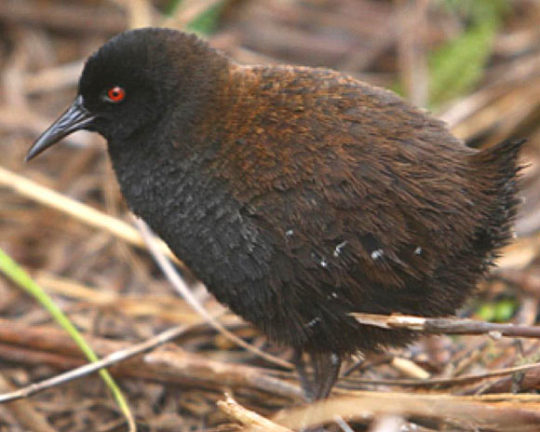
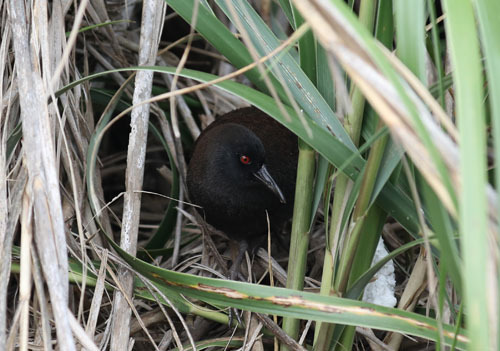
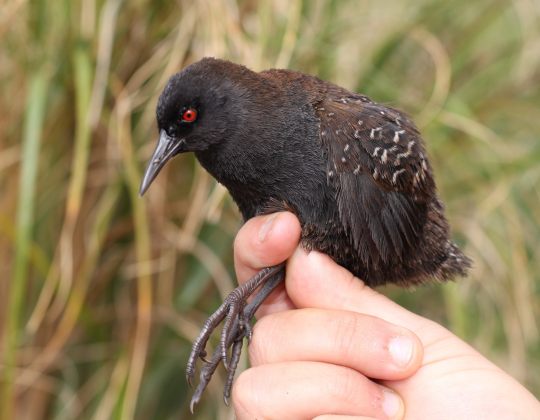
Access Denied: The Inaccessible Island Rail
The Inaccessible Island rail (Laterallus rogersi) is a rarely seen member of the rail family, Rallidae. Part of the reason for its obscurity is the place in which it resides: Inaccessible Island, part of the Tristan da Cunha archipelago in the southern Atlantic Ocean. These islands are extremely remote, and until 2019 it was unclear how L. rogersi even came to be there. We now know that the species colonized the island some 1.5 million years ago, originally coming in from South America and subsequently losing its ability to fly.
In addition to its unique evolutionary history, the Inaccessible Island rail's greatest claim is that it is the smallest flightless bird in the world. Individuals weigh between 35 to 49 g (1.2–1.7 oz) and can be 13 to 15.5 cm (5.1–6.1 in) long from beak to tail. Members of both sexes are dark brown with red eyes; some may have white striping along the underbelly or wings. Females tend to be slightly smaller and lighter in color than males.
The Inaccesible Island rail can be found on all habitats on the island in which it inhabits; these include low mountains and fern brush though the species is most abundant in the grasslands that grow close to the rocky shore. Within these habitats, L. rogersi is largely diurnal. They freely forage for invertebrates, including earthworms, beetles, and moths, as well as seeds and berries; as they have no natural predators they have few defenses against potential threats, although they can run extremely fast when alarmed.
Adults are highly territorial, and when two rivals of either sex encounter each other they will display by lowering their heads, circling each other, and calling loudly until one of them concedes. Males and females mate for life, and build nests in the tall grass. The breeding season is between October and January, in late summer, and females lay a clutch of 2 eggs. Both parents take turns incubating the eggs until they hatch. Chicks can be vulnerable to predation by the migratory brown skua, so parents guard the nest fiercely. The time it takes for chicks to fully mature is unknown, as is the average lifespan in the wild.
Conservation status: The Inaccessible Island rail is considered Vulnerable by the IUCN. The island's population is believed to stand at about 5,600 adult birds. While the island's ecology is currently stable, researchers believe the species would be seriously imperaled if invasive species such as house mice, feral cats and brown rats were introduced. Access to the island is currently restricted, and the island has been declared a nature reserve by the Tristan da Cunha Island Council.
If you like what I do, consider leaving a tip or buying me a kofi!
Photos
Peter G. Ryan
#inaccessible island rail#Gruiformes#Rallidae#rails#birds#islands#island birds#grasslands#grassland birds#Atlantic ocean#animal facts#biology#zoology
950 notes
·
View notes
Text

Eumolpus asclepiadeus Canon 7D EFS 60 2.8 f/7.1 1/400 iso: 160 Milovice, Czech Republic 7/5/2020
#Coleoptera#Chrysomelidae#Chrysomelids#leafBeetles#beetles#insects#invertebrates#macro#grasslands#macrophotography#insectphotography#insect#canon
36 notes
·
View notes
Text
February 12th, 2024


Giant Whip Scorpion (Mastigoproctus giganteus)
Distribution: Found in the southwestern United States, including New Mexico, Arizona, Oklahoma and Texas, down through much of Mexico, as well as Florida.
Habitat: Found in arid habitats; deserts, scrub forests and grasslands, where they take shelter beneath plant debris, in rock crevices or in abandoned animal burrows. Can be found living at altitudes of up to 6000 metres.
Diet: Carnivorous; feeds on a variety of invertebrates, including cockroaches, crickets, millipedes, other arachnids, worms and slugs. Has also been documented feeding on small toads and frogs.
Description: Though their name would suggest otherwise, giant whip scorpions are more closely related to spiders than they are to true scorpions. This species is also referred to as the giant vinegaroon, as it has the capacity to spray a substance containing high concentrations of acetic acid, the same acid found in vinegar. They're able to spray up to 19 times in a row before their pygidial gland is depleted (though it fills up pretty fast; they're usually ready to go again the very next day!). This spray does not usually cause long-term harm, but can occasionally cause the skin to blister, as well as intense pain if it gets into the eyes. Luckily, they only spray when touched—as long as you remain at a respectful distance, you'll be okay! They may also deliver a painful bite or pinch with their powerful chelicerae, though they have no venom.
This species is usually considered to be beneficial, as it often hunts other undesirable arthropods, such as scorpions, as well as agricultural pests that may threaten crops. Giant whip scorpions are also fairly common in the exotic pet trade, as they're non-venomous and have a long lifespan; males can live to 10 years, and females, twice that long!
Images by Bryan Maltais and Diego Barrales.
114 notes
·
View notes
Text
An outstanding wildlife and community site in Essex is under serious threat from the development of up to 1,000 houses.
Locally known as ‘the Wick’, this 76ha mosaic of flowery acid grassland, sandy slopes, scrub, woodland and hedgerows is home to a rich diversity of animals.
The Wick is a key breeding area for the second-best population of Red Listed Nightingale in the UK, and a home to nesting Skylarks and Vulnerable Barbastelle Bats. It supports almost 1,500 invertebrate species, including a quarter of all the UK’s spiders and a quarter of all the butterflies and moths found in Essex.
We need your help to secure the future of this nationally important haven for wildlife- please sign our petition and help to save the Middlewick Ranges.
46 notes
·
View notes
Text
Bird of the Week: The Spur-Winged Lapwing/Spur-Winged Plover! 🪶

The spur-winged lapwing, or spur-winged plover (not to be confused with the masked lapwing) is a medium sized wading bird. They belong to the Charadriidae family, along with other lapwings and plovers.
Wetlands, freshwater/saltwater shores, and grasslands are ideal habitats for the spur-winged lapwing.

The most unique feature of this lapwing is the small claw, or spur, that can be found on their wings. They are not, however, the only bird with this feature. Masked lapwings and spur-winged geese do as well. These spurs can often be tucked under feathers.

Spur-winged lapwings feed on small fish and invertebrates, including insects, crustaceans, and mollusks.
Lapwings are well known for their protective and territorial behavior. Any perceived threat to their nests is likely to be dive-bombed.

#birds#bird of the week#bird identification#birdblr#birding#ornithology#spur-winged lapwing#lapwing#plover#wildlife#bird#nature
33 notes
·
View notes
Text
Pigs are active in the morning and evening.
Pigs only sweat from the disc of the snout.
They like wallowing to cool down, and seeking shade.
Wallowing also helps with parasites – tree rubbing also.
Pigs are omnivores –
In spring and summer, pigs forage on more open
grassland and marshland where they feed on
grass, roots, tubers and invertebrates.
Most feeding in
autumn occurs in woodland where they will gorge on
acorns, nuts and berries to last them during the sparse
winter months.
Pigs also eat a large range of
vertebrates including frogs, snakes, turtles,
the young and eggs of ground nesting birds and have been known
to prey on small rodents.
Carrion is also devoured.
21 notes
·
View notes